
Elf
From Wikipedia, the free encyclopedia.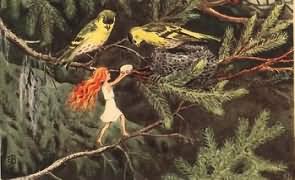
A small forest elf (älva) rescuing an egg, from Solägget (1932), by Elsa Beskow
An elf is a mythical creature of Germanic mythology which survived in northern European folklore. Originally a race of minor gods of nature and fertility, elves are often pictured as youthful-seeming men and women of great beauty living in forests and other natural places, underground, or in wells and springs. They have been portrayed to be long-lived or immortal and magical powers have been attributed to them.
Following the success of J.R.R. Tolkien's epic The Lord of the Rings—wherein a wise, angelic people named elves play a significant role—they have become staple characters of modern fantasy.
Elf can be pluralized both as elves and elfs. Something associated with elves or the qualities of elves is described by the adjectives elfin, elven, elfish, or elvish. They are also called:
Germany: Elfen, Elben and Alben, Great Britain: addler Iceland: álfar, álfafólk and huldufólk Scandinavia: elvere or ellefolk in Denmark, alver or elvefolk in Norway, and alfer, alver or älvor in Sweden Although there has been debate, the words elf, álf and their relatives almost certainly come from the same Indo-European root: albh as the Latin albus (white).
Characteristics of Traditional Elves
Elves in Norse mythology The earliest preserved description of elves comes from Norse mythology, the by far best known version of the earlier Germanic mythology. In Old Norse they are called álfar (singular, nominative case: álfr), and although no older or contemporary descriptions exist, the appearance of beings etymologically related to álfar in various later folklore strongly suggests that the belief in elves were common among all the Germanic tribes, and not limited solely to the ancient Scandinavians.
Elves make various appearances in Norse mythology. Although the concept itself is never clearly defined in our sources, elves appear to have been understood as powerful and beautiful human-sized beings. They are commonly referred to collectively as semi-divine beings associated with fertility as well as the cult of the ancestors.
As such, elves appear similar to the animistic belief in spirits of nature and of the deceased, common to nearly all human religions; something that, on a side note, is true also for the Old Norse belief in fylgjur and vörðar ("follower" and "warden" spirits, respectively). Arguably, elves are the Germanic equivalent to the nymphs of Greek and Roman mythology, as well as the vili and rusalki of Slavic mythology.
The god Freyr, the lord of the light-elvesThe Icelandic mythographer and historian Snorri Sturluson seems to have referred to dwarves (dvergar) as "dark-elves" (dökkálfar) or "black-elves" (svartálfar); whether this usage reflects wider medieval Scandinavian belief is uncertain.
Elves who are not dark-elves are referred to by Snorri as "light-elves" (ljósálfar); this usage has often been connected with elves' etymological connection with whiteness. Snorri describes their differences like so:
There are many magnificent dwellings. One is there called Alfheim. There dwell the folk that are called light-elves; but the dark-elves dwell down in the earth, and they are unlike the light-elves in appearance, but much more so in deeds. The light-elves are fairer than the sun to look upon, but the dark-elves are blacker than pitch.
Evidence for elves in Norse mythology outside Snorri's work, and in earlier evidence, comes from Skaldic poetry, the Poetic Edda and legendary sagas. Here elves are linked with the Æsir, particularly through the common phrase "Æsir and the elves", which presumably means "all the gods".
The elves have been compared or identified with the Vanir (fertility gods) by some scholars (e.g. Hall 2004, pp. 43-46). However, in the Alvíssmál ("The Sayings of All-Wise"), the elves are considered distinct from both the Vanir and the Æsir, as revealed by a series of comparative names in which Æsir, Vanir, and elves are given their own versions for various words in a reflection of their individual racial preferences. Possibly, the words designate a difference in status between the major fertility gods (the Vanir) and the minor ones (the elves).
Grímnismál relates that the Van Freyr was the lord of Álfheimr (meaning "elf-world"), the home of the light-elves. Lokasenna relates that a large group of Æsir and elves had assembled at Ægir's court for a banquet. Several minor forces, the servants of gods, are presented such as Byggvir and Beyla, who belonged to Freyr, the lord of the elves, and they were probably elves, since they were not counted among the gods. Two other mentioned servants were Fimafeng (who was murdered by Loki) and Eldir.
Some speculate that Vanir and elves belong to an earlier Nordic Bronze Age religion of Scandinavia, and were later replaced by the Æsir as main gods. Others (most notably Georges Dumézil) argue that the Vanir were the gods of the common Norsemen, and the Æsir those of the priest and warrior castes (see also Nerthus).
A poem from around 1020, the Austrfaravísur ('Eastern-journey verses') of Sigvatr Þorðarson, mentions that, as a Christian, he was refused board in a heathen household, in Sweden, because an álfablót ("elves' sacrifice") was being conducted there. However, we have no further reliable information as to what an álfablót involved, but like other blóts it probably included the offering of foods, and later Scandinavian folklore retained a tradition of sacrificing treats to the elves.
From the time of year (close to the autumnal equinox) and the elves' association with fertility and the ancestors, we might assume that it had to do with the ancestor cult and the life force of the family.
The smith hero Völundr, the ruler of the elvesIn addition to this, Kormáks saga accounts for how a sacrifice to elves was apparently believed able to heal a severe battle wound: Þorvarð healed but slowly; and when he could get on his feet he went to see Þorðís, and asked her what was best to help his healing.
"A hill there is," answered she, "not far away from here, where elves have their haunt. Now get you the bull that Kormák killed, and redden the outer side of the hill with its blood, and make a feast for the elves with its flesh. Then thou wilt be healed."
The Scandinavian elves were of human size. Full-sized famous men could be elevated to the rank of elves after death, such as the petty king Olaf Geirstad-Elf, and the smith hero Völund (titled as "ruler of elves" in the Völundarkviða).
Even crossbreeding was possible between elves and humans in the Old Norse belief. One case appears in Hrólf Kraki's saga, where the Danish king Helgi finds an elf-woman clad in silk who is the most beautiful woman he has ever seen. He rapes her and later she bears the daughter Skuld, who married Hjörvard, Hrólf Kraki's killer. Another case was the hero Högni, whose mother was a human queen, and whose father, according to the Thidrekssaga, was an elf by the name of Aldrian (though it should be noted that this text is largely translated from German material).
There are also in the Heimskringla and in Þorsteins saga Víkingssonar accounts of a line of local kings who ruled over Álfheim, corresponding to the modern Swedish province Bohuslän, and since they had elven blood they were said to be more beautiful than most men.
The land governed by King Alf was called Alfheim, and all his offspring are related to the elves. They were fairer than any other people ... The last king is named Gandalf.
Scandinavian Elves

Little älvor, playing with Tomtebobarnen. From Children of the Forest (1910) by Swedish author and illustrator Elsa Beskow.
In Scandinavian folklore, which is a later blend of Norse mythology and elements of Christian mythology, an elf is called elver in Danish, alv in Norwegian, and alv or älva in Swedish (the first is masculine, the second feminine). The Norwegian expressions seldom appear in genuine folklore, and when they do, they are always used synonymous to huldrefolk or vetter, a category of earth-dwelling beings generally held to be more related to Norse dwarves than elves.
In Denmark and Sweden, the elves appear as beings distinct from the vetter, even though the border between them is diffuse. The insect-winged fairies in the folklore of the British Isles are often called "älvor" in modern Swedish or "alfer" in danish, although the correct translation is "feer."
In a similar vein, the alf found in the fairy tale The Elf of the Rose by Danish author H. C. Andersen is so tiny that he can have a rose blossom for home, and has "wings that reached from his shoulders to his feet".
Yet, Andersen also wrote about elvere in The Elfin Hill. The elves in this story are more alike those of traditional Danish folklore, who were beautiful females, living in hills and boulders, capable of dancing a man to death. Like the huldra in Norway and Sweden, they are hollow when seen from the back. Small wingless elves of British folklore also appear distinct thus Santa's Elves at called "tomte" in Swedish or "nisse" in Danish.
The elves of Norse mythology have survived into folklore mainly as females, living in hills and mounds of stones[He-1] (cf. Galadriel's account of what would happen to the Elves who remained in Middle-Earth). The Swedish älvor (sing. älva) were stunningly beautiful girls who lived in the forest with an elven king. They were long-lived and light-hearted in nature. The elves are typically pictured as fair-haired, white-clad and like most creatures in the Scandinavian folklore can be really nasty when offended. In the stories, they often play the role of disease-spirits.
The most common, though also most harmless case was various irritating skin rashes, which were called älvablåst (elven blow) and could be cured by a forceful counter-blow (a handy pair of bellows was most useful for this purpose). Skålgropar, a particular kind of petroglyph found in Scandinavia, were known in older times as älvkvarnar (elven mills), pointing to their believed usage. One could appease the elves by offering them a treat (preferably butter) placed into an elven mill – perhaps a custom with roots in the Old Norse álfablót.
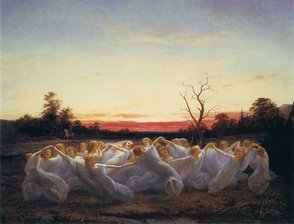
Ängsälvor, "meadow elves", (1850), painting by Nils
Blommér.The elves could be seen dancing over meadows,
particularly at night and on misty mornings. They left a kind of
circle were they had danced, which were called älvdanser
(elf dances) or älvringar (elf circles), and to urinate in
one was thought to cause venereal diseases.
Typically, it consisted of a ring of small mushrooms, but there
was also another kind of elf circle.
On lake shores, where the forest met the lake, you could find elf circles. They were round places where the grass had been flattened like a floor. Elves had danced there. By Lake Tisaren, I have seen one of those. It could be dangerous and one could become ill if one had trodden over such a place or if one destroyed anything there.
If a human watched the dance of the elves, he would discover that even though only a few hours seemed to have passed, many years had passed in the real world. (This time phenomenon is retold in Tolkien's Lord of the Rings when the Fellowship of the Ring discovers that time seems to have run more slowly in elven Lothlórien. It also has a remote parallel in the Irish sídhe.)
In a song from the late Middle Ages about Olaf Liljekrans, the elven queen invites him to dance. He refuses, he knows what will happen if he joins the dance and he is on his way home to his own wedding. The queen offers him gifts, but he declines. She threatens to kill him if he does not join, but he rides off and dies of the disease she sent upon him, and his young bride dies of a broken heart.
However, the elves were not exclusively young and beautiful. In the Swedish folktale Little Rosa and Long Leda, an elvish woman (älvakvinna) arrives in the end and saves the heroine, Little Rose, on condition that the king's cattle no longer graze on her hill. She is described as an old woman and by her aspect people saw that she belonged to the subterraneans.
German elves What remained of the belief in elves in German folklore was that they were mischievous pranksters that could cause disease to cattle and people, and bring bad dreams to sleepers. The German word for nightmare, Albtraum, means "elf dream".
The archaic form Albdruck means "elf pressure"; it was believed that nightmares are a result of an elf sitting on the dreamer's chest. This aspect of German elf-belief largely corresponds to the Scandinavian belief in the mara. It is also similar to the legends regarding incubi and succubi.
As noted above, an elven king occasionally appears among the predominantly female elves in Denmark and Sweden. In the German middle-age epic the Nibelungenlied, a dwarf named Alberich play an important role. Alberich literally translates as "elf-sovereign", further contributing to the elf–dwarf confusion observed already in the Younger Edda. Via the French Alberon, the same name has entered English as Oberon – king of elves and fairies in Shakespeare's A Midsummer Night's Dream (see below).
The legend of Der Erlkönig appears to have originated in fairly recent times in Denmark and Goethe based his poem on "Erlkönigs Tochter" ("Erlkönig's Daughter"), a Danish work translated into German by Johann Gottfried Herder.
The Erlkönig's nature has been the subject of some debate. The name translates literally from the German as "Alder King" rather than its common English translation, "Elf King" (which would be rendered as Elfenkönig in German). It has often been suggested that Erlkönig is a mistranslation from the original Danish ellerkonge or elverkonge, which does mean "elf king".
According to German and Danish folklore, the Erlkönig appears as an omen of death, much like the banshee in Irish mythology. Unlike the banshee, however, the Erlkönig will appear only to the person about to die. His form and expression also tell the person what sort of death they will have: a pained expression means a painful death, a peaceful expression means a peaceful death. This aspect of the legend was immortalised by Goethe in his poem Der Erlkönig, later set to music by Schubert.
In the Brothers Grimm fairy tale Der Schuhmacher und die Heinzelmännchen, a group of naked, one foot tall beings called Heinzelmännchen help a shoemaker in his work. When he rewards their work with little clothes, they are so delighted, that they run away and are never seen again. Even though Heinzelmännchen are akin to beings such as kobolds and dwarves, the tale has been translated to English as The Shoemaker and the Elves, (probably due to the similarity of the henzelmannchen to Scottish brownies) and is echoed in J. K. Rowling's Harry Potter stories.
English Elves
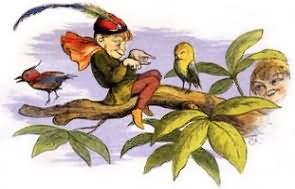
Poor little birdie teased, by Victorian era illustrator Richard Doyle depicts the traditional view of an elf from later English folklore as a diminutive woodland humanoid.
The word elf came into English as the Old English word ælf (pl. ælfe, with regional and chronological variants such as ylfe and ælfen), and so came to Britain originally with the Anglo-Saxons.
Words for the nymphs of the Greek and Roman mythos were translated by Anglo-Saxon scholars with ælf and variants on it.
Although our early English evidence is slight, there are reasons to think that Anglo-Saxon elves (ælfe) were similar to early elves in Norse mythology: human-like, human-sized supernatural beings, capable of helping or harming the people who encountered them. In particular, the pairing of æsir and álfar found in the Poetic Edda is mirrored in the Old English charm Wið færstice and in the distinctive occurrence of the cognate words os and ælf in Anglo-Saxon personal names (e.g. Oswald, Ælfric ).
In relation to the beauty of the Norse elves, some further evidence is given by old English words such as ælfsciene ("elf-beautiful"), used of seductively beautiful Biblical women in the Old English poems Judith and Genesis A.
Although elves could be considered to be beautiful and potentially helpful beings in some sections of English-speaking society throughout its history, Anglo-Saxon evidence also attests to alignments of elves with demons, as for example in line 112 of Beowulf. On the other hand, oaf is simply a variant of the word elf, presumably originally referring to a changeling or to someone stupefied by elvish enchantment.
Little documentation exists on English rustic beliefs and terminology before the 19th century, but it seems that the term elf was used, at least on some occasions or in some places, for various kinds of uncanny wights, either human-sized or smaller. But other terms were also used.
Elf-shot (or elf-bolt or elf-arrow) is a word found in Scotland and Northern England, first attested in a manuscript of about the last quarter of the 16th century. Although first attested in the sense 'sharp pain caused by elves', it is later attested denoting Neolithic flint arrow-heads, which by the 17th century seem to have been attributed in Scotland to elvish folk, and which were used in healing rituals, and alleged to be used by witches (and perhaps elves) to injure people and cattle.
So too a tangle in the hair was called an elf-lock, as being caused by the mischief of the elves, and sudden paralysis was sometimes attributed to elf-stroke. Compare with the following excerpt from an 1750 ode by Willam Collins:
There every herd, by sad experience, knows How, winged with fate, their elf-shot arrows fly, When the sick ewe her summer food forgoes, Or, stretched on earth, the heart-smit heifers lie.
The elf makes many appearances in ballads of English and Scottish origin, as well as folk tales, many involving trips to Elphame or Elfland (the Álfheim of Norse mythology), a mystical realm which is sometimes an eerie and unpleasant place. The elf is often portrayed in a positive light, such as the Queen of Elphame in the ballad Thomas the Rhymer, but examples exist of the elf has a sinister character, as in the Tale of Childe Rowland, or the ballad Lady Isabel of the Elf-Knight, in which the Elf-Knight bears away Isabel to murder her. In none of these cases is the elf a spritely character with pixie-like qualities.
English folktales of the early modern period typically portray elves as small, elusive people with mischievous personalities. They are not evil but might annoy humans or interfere in their affairs. They are sometimes said to be invisible. In this tradition, elves became more or less synonymous with the fairies that originated from native British mythology, for example, the Welsh Ellyll (plural Ellyllon) and Y Dynon Bach Têg.
"To make my small elves coats; and some keep back." One of Arthur Rackham's illustrations to William Shakespeare's A Midsummer Night's Dream.
Successively, the word elf, as well as literary term fairy, evolved to a general denotation of various nature spirits like pwcca, hobgoblin, Robin Goodfellow, the Scots brownie, and so forth. These terms, like their relatives in other European languages, are no longer clearly distinguished in popular folklore.
Significant for the distancing of the concept of elves from its mythological origins was the influence from literature. In Elizabethan England, William Shakespeare imagined elves as little people. He apparently considered elves and fairies to be the same race. In Henry IV, part 1, act II, scene iv, he has Falstaff call Prince Henry, "you starveling, you elfskin!", and in his A Midsummer Night's Dream, his elves are almost as small as insects. On the other hand, Edmund Spenser applies elf to full-sized beings in The Faerie Queene.
The influence of Shakespeare and Michael Drayton made the use of elf and fairy for very small beings the norm. In Victorian literature, elves usually appeared in illustrations as tiny men and women with pointed ears and stocking caps. An example is Andrew Lang's fairy tale Princess Nobody (1884), illustrated by Richard Doyle, where fairies are tiny people with butterfly wings, whereas elves are tiny people with red stocking caps. There were exceptions to this rule however, such as the full-sized elves who appear in Lord Dunsany's The King of Elfland's Daughter.
Modern elves
Elves at Christmas
 Tony Cox as
Marcus in the movie Bad Santa, who is working as an elf assisting
Santa Claus at a supermarket.In USA, Canada, and the United
Kingdom, the modern children's folklore of Santa Claus typically
includes diminutive, green-clad elves as Santa's assistants. They
wrap Christmas gifts and make toys in a workshop located in the
Arctic. In this portrayal, elves slightly resemble nimble and
delicate versions of the dwarfs of Norse mythology.
Tony Cox as
Marcus in the movie Bad Santa, who is working as an elf assisting
Santa Claus at a supermarket.In USA, Canada, and the United
Kingdom, the modern children's folklore of Santa Claus typically
includes diminutive, green-clad elves as Santa's assistants. They
wrap Christmas gifts and make toys in a workshop located in the
Arctic. In this portrayal, elves slightly resemble nimble and
delicate versions of the dwarfs of Norse mythology.
The vision of the small but crafty Christmas elf has come to influence modern popular conception of elves, and sits side by side with the fantasy elves following Tolkien's work (see below). The American cookie company Keebler has long advertised that its cookies are made by elves in a hollow tree, and Kellogg's, who happens to now be the owner of Keebler, uses the elves of Snap, Crackle, and Pop as mascots of Rice Krispies cereal, and the role of elves as Santa's helpers has continued to be popular, as evidenced by the success of the movie Elf.
Elves in modern fantasy
Modern fantasy literature has revived the elves as a race of semi-divine beings of human stature. Fantasy elves are different from Norse elves, but are more akin to that older mythology than to folktale elves – they are unlikely to sneak in at night and help a cobbler mend his shoes.
These elves are typically derived from the Elves of J. R. R. Tolkien (see below), though he was not the first to draw inspiration from the Norse álfar: the grim Norse-style elves of human size introduced Poul Anderson's fantasy novel The Broken Sword from 1954 are one of the first precursors to modern fantasy elves.
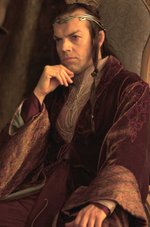 Hugo Weaving
portrays Elrond the half-elf, lord of Rivendell, in one film
interpretation of The Lord of the Rings. The twentieth-century
philologist and fantasy writer J. R. R. Tolkien had little use
for Shakespearean fairy portrayals or for Victorian diminutive
fairy prettiness and whimsy, aligning his elves with the god-like
and human-sized ljósálfar of Norse mythology. He
conceived a race of beings similar to humans but fairer and
wiser, with greater spiritual powers, keener senses, and a closer
empathy with nature. They are great smiths and fierce warriors on
the side of good. Tolkien's Elves of Middle-earth should be seen
as a representation of what human beings might have become, had
they not committed the original sin, and they are very much
human, if Unfallen and immortal; and although they can be killed
by injury, and they do age, according to Tolkien's Letters, a
slain Elf simply returns to life after an indefinite period of
time.
Hugo Weaving
portrays Elrond the half-elf, lord of Rivendell, in one film
interpretation of The Lord of the Rings. The twentieth-century
philologist and fantasy writer J. R. R. Tolkien had little use
for Shakespearean fairy portrayals or for Victorian diminutive
fairy prettiness and whimsy, aligning his elves with the god-like
and human-sized ljósálfar of Norse mythology. He
conceived a race of beings similar to humans but fairer and
wiser, with greater spiritual powers, keener senses, and a closer
empathy with nature. They are great smiths and fierce warriors on
the side of good. Tolkien's Elves of Middle-earth should be seen
as a representation of what human beings might have become, had
they not committed the original sin, and they are very much
human, if Unfallen and immortal; and although they can be killed
by injury, and they do age, according to Tolkien's Letters, a
slain Elf simply returns to life after an indefinite period of
time.
Tolkien's The Lord of the Rings (1954-1958) became astoundingly popular and was much imitated. In the 1960s and afterwards, elves similar to those in Tolkien's novels became staple non-human characters in high fantasy works and in fantasy role-playing games (RPGs). Tolkien's Elves were enemies of goblins (orcs) and had a longstanding quarrel with the Dwarves -- these motifs often reappear in Tolkien-inspired works. Tolkien is also responsible for reviving the older and less-used terms elven and elvish rather than Edmund Spenser's invented elfin and elfish. He probably preferred the word elf over fairy because elf is of Anglo-Saxon origin while fairy entered English from French.
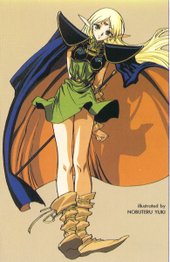 Post-Tolkien
fantasy elves Deedlit, the female elf from the Dungeons and
Dragons inspired anime series Record of the Lodoss War, is an
example of a modern fantasy elf.
Post-Tolkien
fantasy elves Deedlit, the female elf from the Dungeons and
Dragons inspired anime series Record of the Lodoss War, is an
example of a modern fantasy elf.
Post-Tolkien fantasy elves (popularized by the Dungeons and Dragons role-playing game) tend to be beautiful, fair, slender, human-sized or only slightly smaller than humans, and possess unearthly speed and agility. A hallmark of fantasy elves is also their long and pointed ears. The length and shape of these ears varies depending on the artist or medium in question. For example, while most elves in Western Fantasy have ears only slightly longer than humans', elves depicted in anime tend to have very long ears that stand out at dramatic angles from their faces(see picture). Other artists may use any combination of these features, to greater or lesser degrees.
In gaming, and to some extent fantasy literature, elves as a rule have a greater depth of knowledge (especially regarding magic) than their human counterparts, due to a racial inclination as well as their extreme age. Conversely, they may be also depicted as arrogant(not without reason in many cases), and are often shown as rivals, or distrustful, of Dwarves. Typically, they are also capable warriors, especially skilled in archery, following Legolas, arguably Tolkien's most well-known elf. The canonical role-playing style elf is represented by Deedlit, a major character of the anime series Record of the Lodoss War.
As in the Norse lore, elven–human unions were possible in Tolkien's saga (a notable example being Elrond, the lord of Rivendell), and in many RPG's, half-elven is a possible race for player characters. Fantasy elves frequently divide up into subraces, such as the High Elves, Wood Elves and Dark Elves found in the Warhammer Fantasy game setting. Especially dark elves (popularized by TSR as drow) are a common theme in many other fantasy games and to some extent literature. Apart from malice, drow or dark elves tend to be characterized by a dark or blue skin color, and by an underground abode.
Elves have become standardized staple characters of modern fantasy to such an extent that breaking the norms for how an elf is supposed to be and behave has become an end in itself for certain works of fantasy. Wendy and Richard Pini's long-running comic books Elfquest attempts to avoid the usual Tolkienesque elven clichés by placing their elves in a setting inspired by Native American rather than European mythology; and the Discworld elves in the novels by Terry Pratchett are extradimensional, emotionless monsters. Radiata Stories features beings called Light Elves which have an appearance more like a fairy or pixie than of a traditional elf.
Towards the end of the 20th century, a number of people have begun to describe themselves as elves, usually more of the Tolkien than the folkloric Santa type. Many of these people can be found in the Otherkin subculture.
Elves in the Harry Potter books were called House-elves,who were essentially servants to wizards' families.The first House-elf we meet is Dobby,who first appeared in Harry Potter and the Chamber of Secrets.

